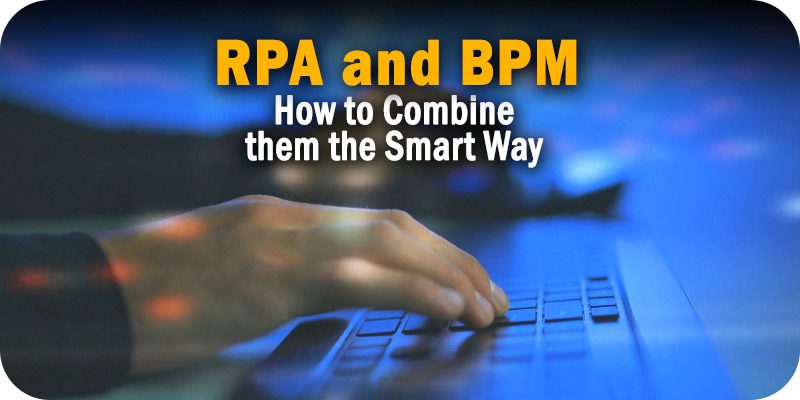How to Combine RPA and BPM the Smart Way


As part of Solutions Review’s Expert Insights Series—a collection of contributed articles written by industry experts in enterprise software categories—Lou Bachenheimer, the CTO of Americas at SS&C Blue Prism, explains how companies can combine RPA and BPM solutions the smart way.
 Managing business processes has moved beyond simple task-based automation in a digital-first world. Today’s top organizations realize the need for a comprehensive approach to business process management (BPM) to meet customer and market demands for speed and convenience at low costs. This means digitized end-to-end processes that combine BPM solutions with robotic process automation (RPA). This allows for the seamless integration of their digital solutions with their human workforce. However, to secure long-term success and viability, companies must ensure their RPA and BPM solutions are orchestrated from a single comprehensive platform.
Managing business processes has moved beyond simple task-based automation in a digital-first world. Today’s top organizations realize the need for a comprehensive approach to business process management (BPM) to meet customer and market demands for speed and convenience at low costs. This means digitized end-to-end processes that combine BPM solutions with robotic process automation (RPA). This allows for the seamless integration of their digital solutions with their human workforce. However, to secure long-term success and viability, companies must ensure their RPA and BPM solutions are orchestrated from a single comprehensive platform.
What Businesses Get Wrong
Companies worldwide spend an estimated $230 billion on managing business processes. While RPA and BPM are powerful stand-alone tools, organizations miss out on a host of transformational benefits if they fail to unleash the capabilities of these solutions when used together.
Any adopted platform should utilize the complementary benefits of other advanced technologies like machine learning (ML), artificial intelligence (AI), intelligent document processing, and human-in-the-loop capabilities. It’s also essential for the platform to include process intelligence tools, such as process mining and task mining, to pre-populate BPM and RPA flows and provide enhanced monitoring capabilities.
For example, while BPM is great at orchestration, it cannot directly interact with legacy systems. On the flip side, RPA is excellent at automating any user interface but struggles with long-term case management. Combining the two creates a complete solution that can tackle end-to-end processes. Robotic process automations are managed under BPM software, using automations wherever possible.
Humans are looped in as desired to ensure they agree with the BPM system’s delegation and coordination of tasks and processes across human and digital workers. The operational transformation will optimize the experience for customers and employees alike. These effects will reverberate across the organization thanks to the scalability of BPM and RPA used within an intelligent automation (IA) platform.
Businesses combining RPA and BPM in a single IA platform can create opportunities for competitive advantages if they are willing to invest the time and resources needed to find the right platform and implement it effectively.
Technical Debt Adds Up
Seamless digital integration is more than just cobbling together the best digital solutions on the market. How these advanced technologies interact makes a huge difference. Technologies designed to work together are crucial to achieving the productivity gains promised by digital transformation. With a comprehensive platform, organizations don’t need to worry about building integrations because the platform already includes them.
Moreover, a single platform is easier to buy and manage because it comes from the same licensor rather than going through the procurement process with multiple suppliers. Companies need to take care when determining which IA platform to adopt. The benefits of a comprehensive platform are increasingly recognized by vendors and their customers, pushing suppliers to put together multifeatured automation platforms. If companies choose a platform insufficient for their needs, they face reworking costs down the road.
Nevertheless, suppose organizations have already taken on technical debt and are looking to rework their digital transformation journey. In that case, the right partner can help them minimize reworking costs to achieve the most benefit. For example, it may be best for a company to adopt a new BPM for projects moving forward and retain its existing BPM for processes it already manages.
A Single Platform in Action
By combining the potentials of RPA and BPM, organizations can achieve scale. This was critical for the American Paycheck Protection Program (PPP), which was created to help small businesses through the economic shutdown caused by pandemic lockdowns through the provision of $800 billion in low-interest uncollateralized loans. Millions of companies applied for critically needed financial support from the PPP program. Submitting these applications was a simple RPA task; managing the ongoing cases as businesses subsequently applied for loan forgiveness required BPM. With BPM, RPA was used where possible (for automated emails, sending back information, etc.), and humans were used where needed (for final reviews and complicated tasks).
The time-sensitive nature of PPP and its scale would not have been achievable without BPM and RPA. With BPM and RPA, organizations can coordinate processes and avoid the inevitable human errors that arise from manual data input. This is especially important in healthcare and financial services. Errors in financial services can cost firms and their customers money and lost investment opportunities. The stakes are even higher in healthcare, where patients’ lives are on the line. Data errors here can lead to patient mix-ups, getting the dose of a medication wrong, and even costing lives.
Using BPM and RPA solutions, patient appointments in healthcare systems can be prioritized, and reminders can be sent to avoid no-shows. This ensures the effective use of resources in a sector with incredibly tight margins. Firms can more easily manage customers’ investment accounts in the financial services sector, increasing productivity and capacity.
Avoiding Common Mistakes
As with any advanced technology, a solution will only work well if implemented and integrated effectively. One of the benefits of a single platform is that the integration and time to value are much faster because adopters only work through one provider. A Center of Excellence to oversee and support organizations’ digitization plans, including RPA, BPM, and other IA components, must be established to ensure success. Executive sponsorship is instrumental in scaling out automation programs. A top-down approach like that will ensure the required resources are provided and that the right work culture is fostered to promote successful digitization.
In our experience, those following the Robotic Operating Model (ROM)—a proven methodology for launching, maintaining, and scaling digital workforces—like TD Bank and Aviva have been able to scale their digital operations quickly and see tremendous returns on their investments as a result.
Digitization is on the rise. More than 65 percent of senior executives are increasing investments in automation and AI. As we move towards a digital-first future, it is no longer sufficient to automate individual processes in isolation to achieve the results businesses strive for. Instead, to maximize impact, entire end-to-end processes need to be reimagined. With the power of BPM and RPA encompassed within an intelligent automation platform offering complementary technologies, these objectives can be achieved seamlessly and cost-effectively.



















